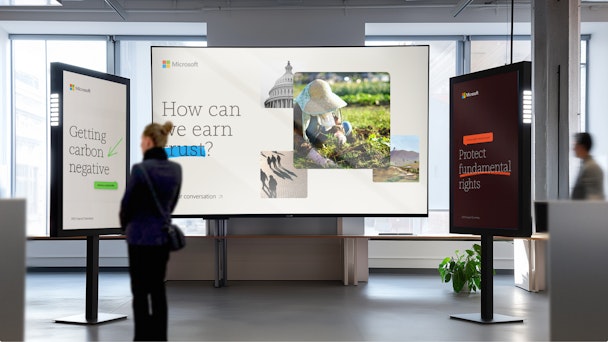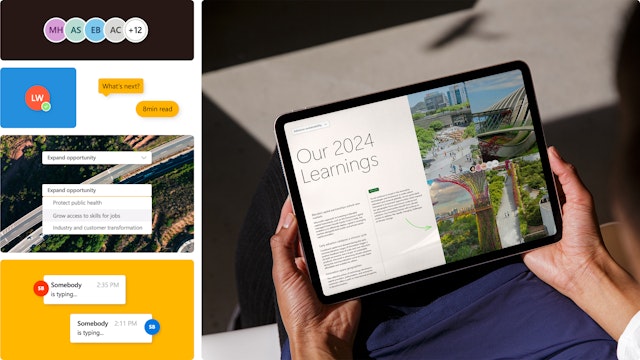Why Microsoft turned to designers to overhaul its social impact strategy
DesignStudio has produced a set of corporate social responsibility (CSR) guidelines, which encourage Microsoft staff to ask critical questions to improve social and environmental outcomes for the company and consumers.

Microsoft's CSR employee engagement / Design Studio
If the internet and its supporting systems were a country, it would be the seventh-most polluting on Earth in terms of greenhouse emissions and this is predicted to double by 2025.
This is one of the stark stop-and-think Green Design Principles that Microsoft has been promoting to its staff in recent years, but not in a very joined-up way.
These principles are signposts towards policies such as simplifying user journeys to reduce content loads and ensuring low-impact product settings are built in as default.

In early 2023, DesignStudio was brought in by Microsoft and tasked with gathering together existing strands of CSR work and creating a set of guidelines that could then be promoted internally and used as a point of reference in everything from marketing campaigns to product development.
Explore frequently asked questions
Underwater servers and cyber-crime
DesignStudio Americas principal Richard Swain says: “The Microsoft brand team initially wanted us to create guidelines for how they talk about public policy, but there was also a lot of interest in making it more central to the Microsoft business and brand.
“There was this belief that they could do a better job of connecting the corporate actions that they’re already taking today with product offerings.”
The business case was that “they could actually increase brand perception around making the world better, which is important to consumers, and therefore lift not just that perception and brand affinity, but also revenue,” adds Swain.
Advertisement
Although this might sound cynical, it’s the practical reality of getting a project like this off the ground, according to Swain, who sees the whole exercise as one of transparency.
Other disparate examples of recent socially responsible Microsoft work include submerging 855 servers underwater near Scotland’s Orkney Isles, where they were left for 25 months to test cooling methods. Results have shown this to be reliable and efficient. Meanwhile, there has been other work to stave off Russian cyber-attacks on the Ukraine army.
Encouraging employees to be critical
However, DesignStudio’s guidelines are less about celebrating current examples of responsible work and more to do with appealing to workers to ask critical questions and challenge the status quo in their own work so that it affects the trajectory of future projects.
According to Swain, this helps to avoid the notion that solving societal and environmental issues is an easy fix. It’s fair to say that an ad-hoc, single-issue-based approach can be a common greenwashing trap for a lot of companies.
Instead, DesignStudio’s approach has been to draw on existing resources, such as sustainability reports and use them to inform anything from business strategy to product development and partnerships, alongside the employee-driven critical questioning.
Advertisement
Exploring Microsoft’s visual language
The new CSR toolkit dovetails with existing brand guidelines based on branding designed in-house in 2020.
Roll out of the new CSR project as a marketing and awareness exercise is leading to white papers, data visualization and social media outputs relying on colors, motion principles and art direction inspired by Microsoft’s UI.
“Graphic annotations were very inspired by the UI and designed to feel really interactive, in the way that circling stuff, typing it and writing it should. We wanted it to feel like it was being used; like it was living and breathing and people were interacting with it,” says Swain, who adds, “That was one of the main goals in the first place.”
The toolkit is appearing across all employee experiences, often posing questions by way of inspiration, sometimes as a physical environment or on digital screens to engage workers.
“Our audience for this has really been the employee because they’re the ones who represent the brand through every decision they make, including the product marketing,” says Swain, adding that it’s easy for employees to disconnect themselves from the company they work for and the products it creates.
The key for Swain’s team was to empower employees with “tools, communications, language and case studies,” but also to realize that CSR isn’t siloed but “the stuff that you guys do each and every day, which you can impact through the decisions you make” says Swain.
Suggested newsletters for you
Employees will need to buy into Microsoft’s sustainable future
In terms of what the toolkit could facilitate next, Swain cites influencing hiring practices, free education programs or free access to Microsoft products as examples, particularly when motivated by searching questions such as “‘Why can’t we do that?’” He hopes it will create a “wheel of positive reinforcement that will connect people, guiding principles and what Microsoft is doing as a business.”
Ultimately, it’s about “earning trust and building a safe digital world,” he says, extending this idea to a contemporary topic such as AI. “AI is a huge pillar for Microsoft, so the question might be, ‘How can we make sure we’re thinking about AI responsibly and sustainably?’”
With lofty aims as a business, such as being carbon negative, water positive and not producing waste by 2030 as part of Microsoft’s sustainability initiative, Swain says: “It’s really going to need all its employees to help drive towards that.”
